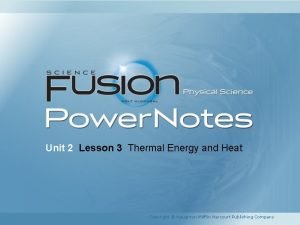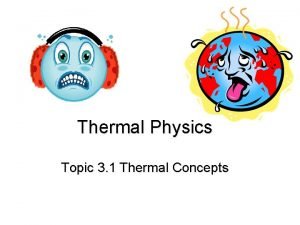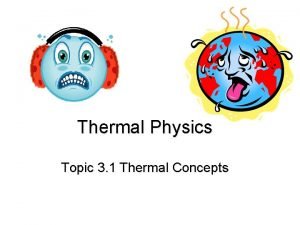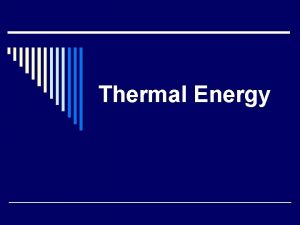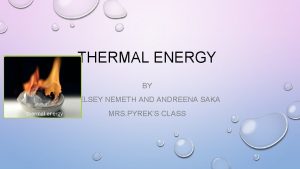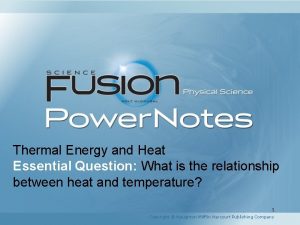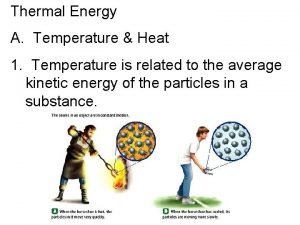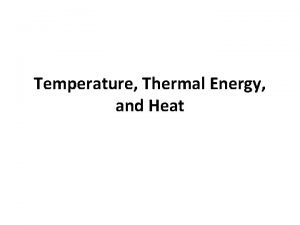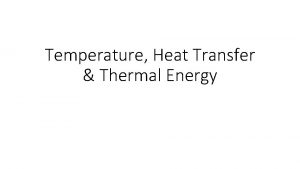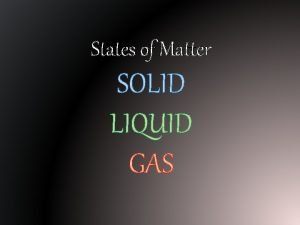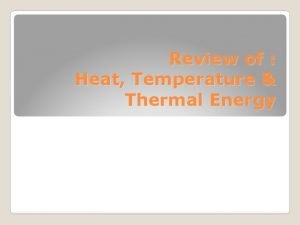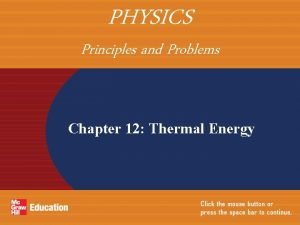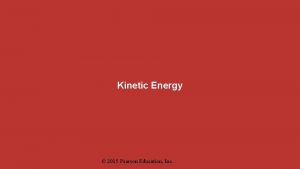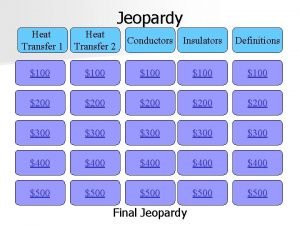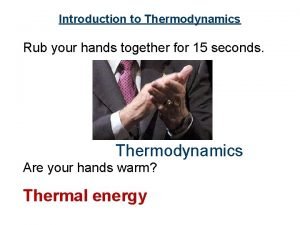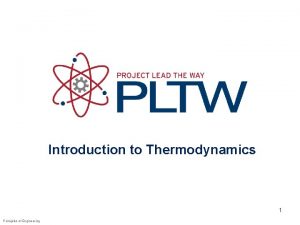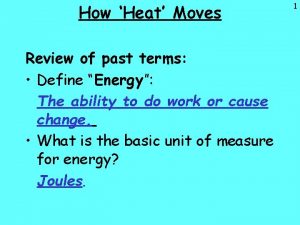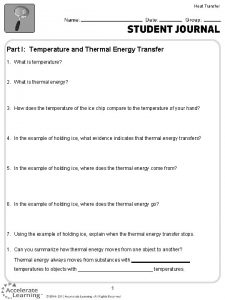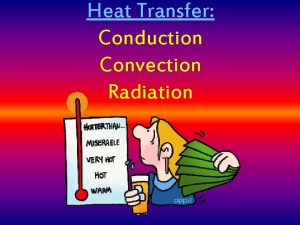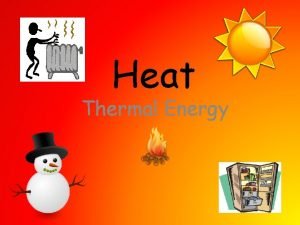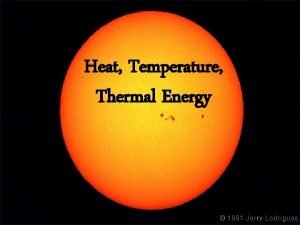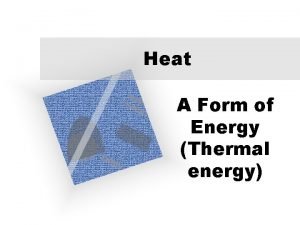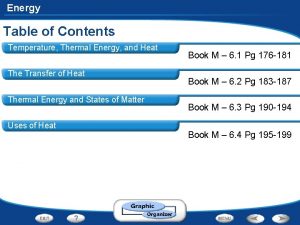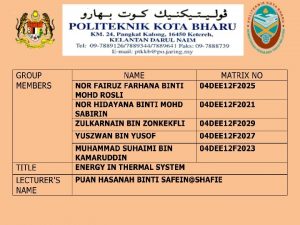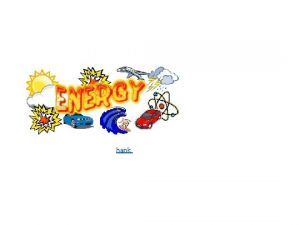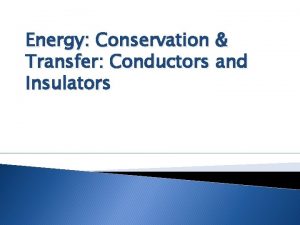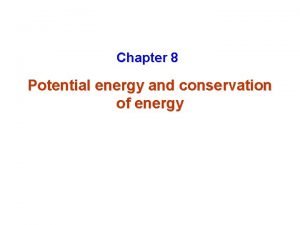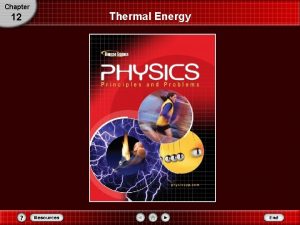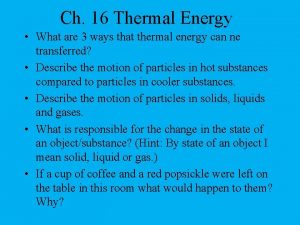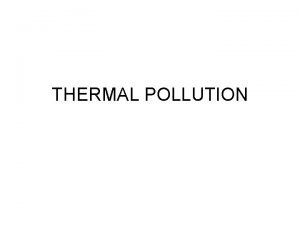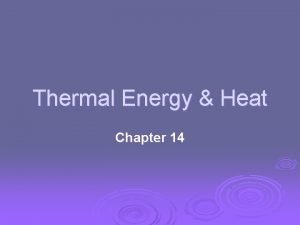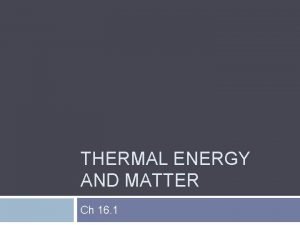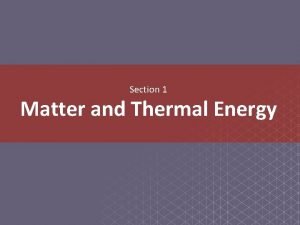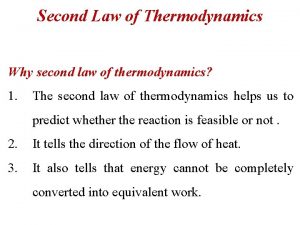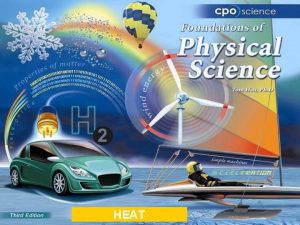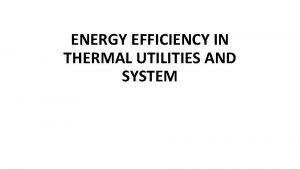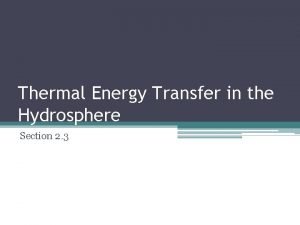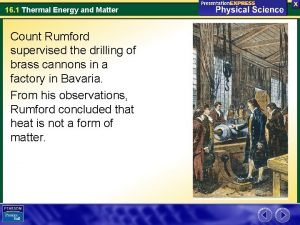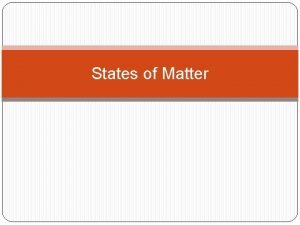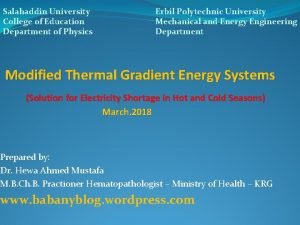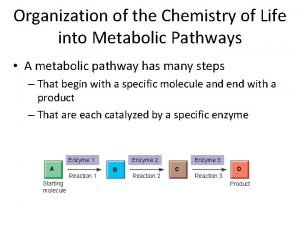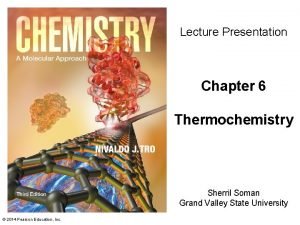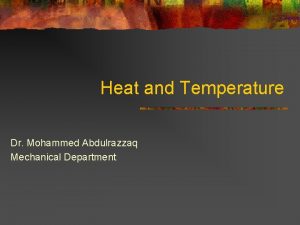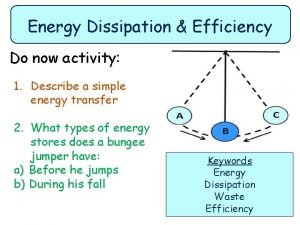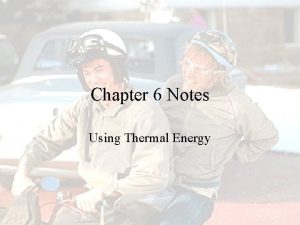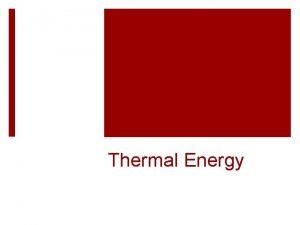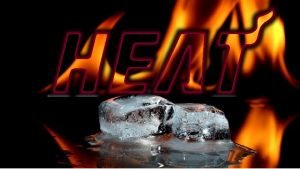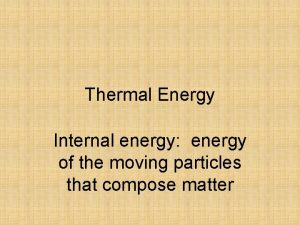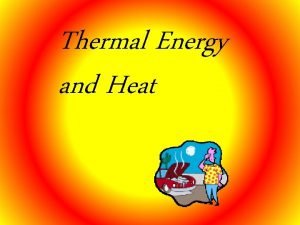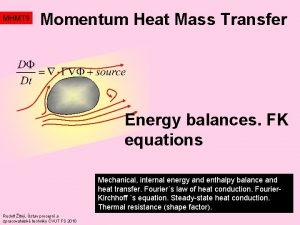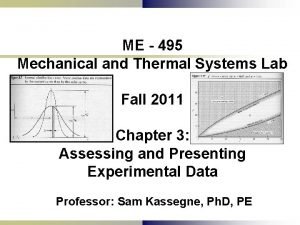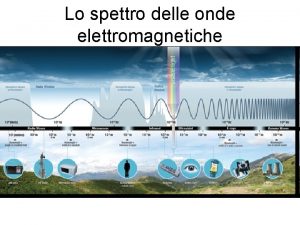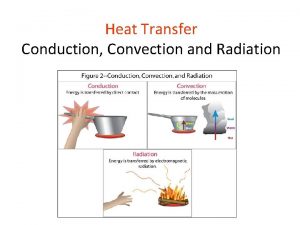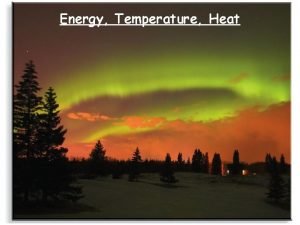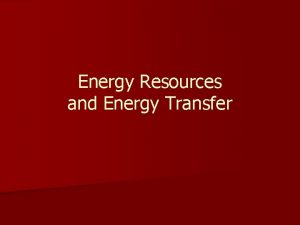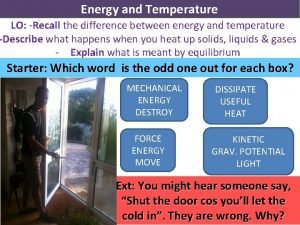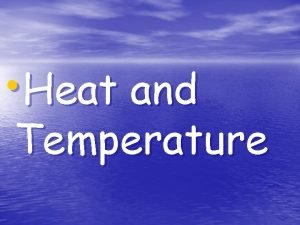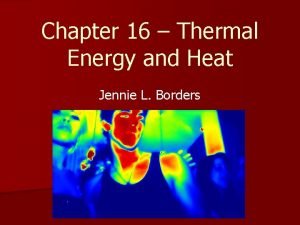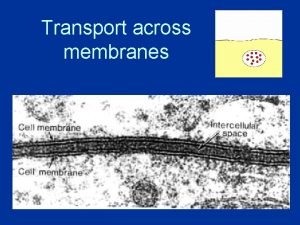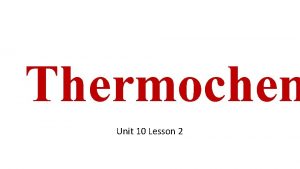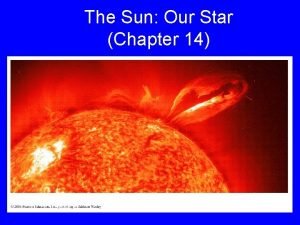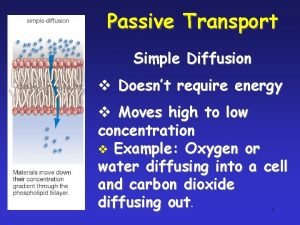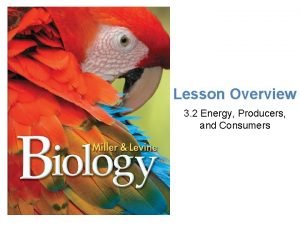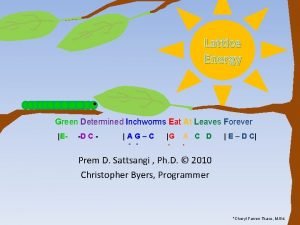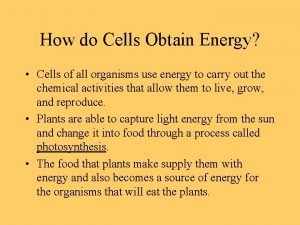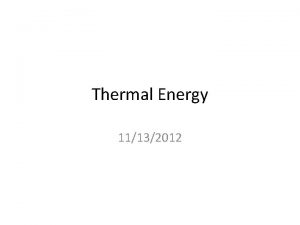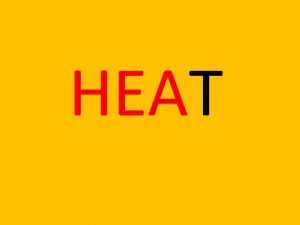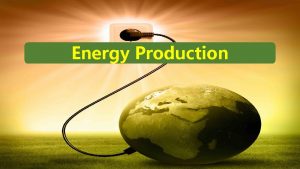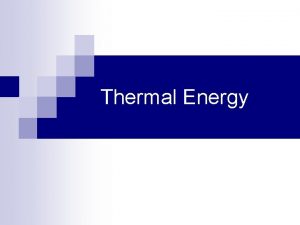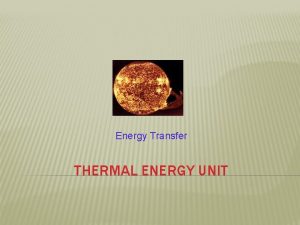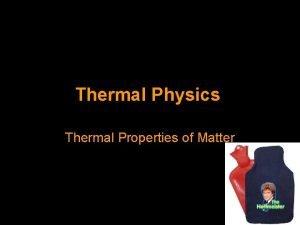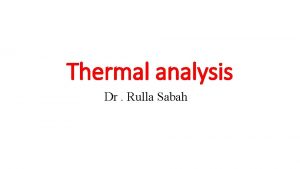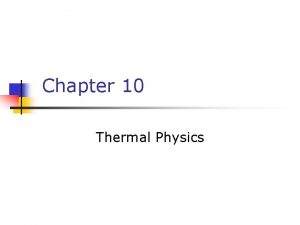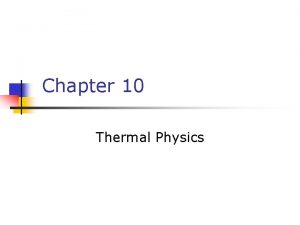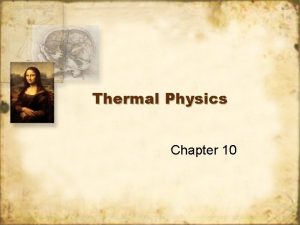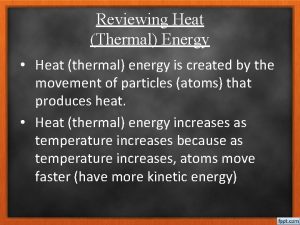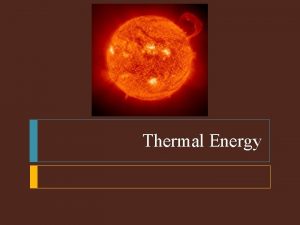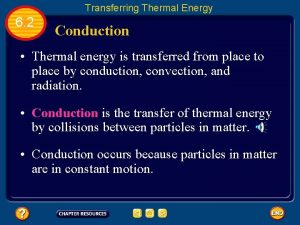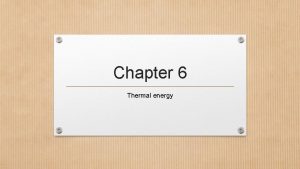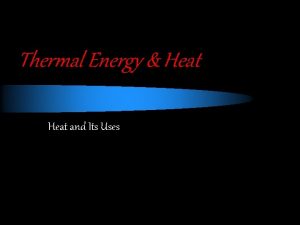Thermal Energy Thermal Energy How does thermal energy




















































































- Slides: 84

Thermal Energy

Thermal Energy How does thermal energy work?

Important terms to know: o Temperature:

Important terms to know: o Temperature: A measure of the average kinetic energy of the individual particles in matter.

Important terms to know: o Temperature: A measure of the average kinetic energy of the individual particles in matter. n Low temperatures = low kinetic energy

Important terms to know: o Temperature: A measure of the average kinetic energy of the individual particles in matter. Low temperatures = low kinetic energy n High temperatures = high kinetic energy n

Important terms to know: o Temperature: continued n Thermometers: As the liquid in thermometer heats up its volume increases (rises) and as it cools off its volume goes down (drops).

Important terms to know: o Temperature: continued n Scales: The three common scales are Fahrenheit, Celsius, and the Kelvin scales.

Important terms to know: o Temperature: continued n Scales: The three common scales are Fahrenheit, Celsius, and the Kelvin scales. p Fahrenheit: Used in the United States.

Important terms to know: o Temperature: continued n Scales: The three common scales are Fahrenheit, Celsius, and the Kelvin scales. p Fahrenheit: Used in the United States. p Celsius: Used nearly everywhere else.

Important terms to know: o Temperature: continued n Scales: The three common scales are Fahrenheit, Celsius, and the Kelvin scales. p Fahrenheit: Used in the United States. p Celsius: Used nearly everywhere else. p Kelvin: Commonly used in the physical sciences.

Important terms to know: o Temperature: continued n Conversions:

Important terms to know: o Temperature: continued Conversions: n °K = °C + 273 n

Important terms to know: o Temperature: continued Conversions: n °K = °C + 273 n °C = °K - 273 n

Important terms to know: o Temperature: continued Conversions: n °K = °C + 273 n °C = °K - 273 n °C = 5/9(°F – 32) n

Important terms to know: o Temperature: continued Conversions: n °K = °C + 273 n °C = °K - 273 n °C = 5/9(°F – 32) n °F = 9/5°C + 32 n

Thermal Energy: o Thermal Energy depends on:

Thermal Energy: o Thermal Energy depends on: n the number of particles an object has.

Thermal Energy: o Thermal Energy depends on: n n the number of particles an object has. the temperature of an object.

Thermal Energy: o Thermal Energy depends on: n n n the number of particles an object has. the temperature of an object. the arrangement of the object’s particles.

Thermal Energy: o Thermal Energy depends on: n n n the number of particles an object has. the temperature of an object. the arrangement of the object’s particles. o Heat:

Thermal Energy: o Thermal Energy depends on: n n n the number of particles an object has. the temperature of an object. the arrangement of the object’s particles. o Heat: n Thermal energy that moves from a warmer object to a cooler object.

Thermal Energy: o Thermal Energy depends on: n n n the number of particles an object has. the temperature of an object. the arrangement of the object’s particles. o Heat: n n Thermal energy that moves from a warmer object to a cooler object. Thermal energy only becomes heat when it is transferred.

Thermal Energy: o Thermal Energy depends on: n the number of particles an object has. n the temperature of an object. n the arrangement of the object’s particles. o Heat: n Thermal energy that moves from a warmer object to a cooler object. n Thermal energy only becomes heat when it is transferred. n It’s unit of measure is “Joules”.


Thermal Energy: o Specific Heat:

Thermal Energy: o Specific Heat: The amount of energy required to raise 1 g of a material by 1 °C.

Thermal Energy: o Specific Heat: The amount of energy required to raise 1 g of a material by 1 °C. o Measured in joules per kilogram-Celsius

Thermal Energy: o Specific Heat: The amount of energy required to raise 1 g of a material by 1 °C. o Measured in joules per kilogram-Kelvin n J/(kg*C)

Thermal Energy: o Common specific heats: n n n n Aluminum: Copper Glass Ice Iron Sand Water 903 J/(kg*C) 385 837 2, 060 450 800 4, 180

Heat Transfer: o Heat is transferred by three different methods.

Heat Transfer: o Heat is transferred by three different methods. n Conduction: The transfer of heat without the movement of matter.

Heat Transfer: o Heat is transferred by three different methods. n Conduction: The transfer of heat without the movement of matter. p. A metal spoon in a pan of hot water (the spoon gets hot over time).

Heat Transfer: o Heat is transferred by three different methods. n Convection: The transfer of heat by the movement of currents within a fluid.

Heat Transfer: o Heat is transferred by three different methods. n Convection: The transfer of heat by the movement of currents within a fluid. p Water heating up in a pot on the stove (you can see the water moving).

Heat Transfer: o Heat is transferred by three different methods. n Convection: The transfer of heat by the movement of currents within a fluid. p Water heating up in a pot on the stove (you can see the water moving). p Convection currents? !? !

Convection current:

Heat Transfer: o Heat is transferred by three different methods. n Radiation: The transfer of energy by electromagnetic waves.

Heat Transfer: o Heat is transferred by three different methods. n Radiation: The transfer of energy by electromagnetic waves. p. A fireplace warming a room.

Heat Transfer: o Heat is transferred by three different methods. n Radiation: The transfer of energy by electromagnetic waves. p. A fireplace warming a room. p Does not require matter to transfer thermal energy (the sun).

Heat Transfer: o Heat flow:

Heat Transfer: o Heat flow: n Heat transfer goes in one direction.

Heat Transfer: o Heat flow: n Heat transfer goes in one direction. p Heat leaves the warmer object and goes to the cooler object.

Heat Transfer: o Heat flow: n Heat transfer goes in one direction. p Heat leaves the warmer object and goes to the cooler object. p This will continue until the two objects have the same temperature.



Heat Transfer: o Conductors:

Heat Transfer: o Conductors: A material that transfers thermal energy well, partially because its atoms or molecules are close together.

Heat Transfer: o Conductors: A material that transfers thermal energy well, partially because its atoms or molecules are close together. n Silver n Stainless steel n tile

Heat Transfer: o Conductors: A material that transfers thermal energy well, partially because its atoms or molecules are close together. n Silver n Stainless steel n tile o Insulators:

Heat Transfer: o Conductors: A material that transfers thermal energy well, partially because its atoms or molecules are close together. n Silver n Stainless steel n tile o Insulators: A material that does not transfer thermal energy very well, partially because its atoms or molecules are not closely packed together.

Heat Transfer: o Conductors: A material that transfers thermal energy well, partially because its atoms or molecules are close together. n Silver n Stainless steel n tile o Insulators: A material that does not transfer thermal energy very well, partially because its atoms or molecules are not closely packed together. n n Wood Wool Paper Atmospheric gases

Thermal Expansion: Does matter with thermal energy?

Matter: o What is matter?

Matter: o What is matter? n Has mass

Matter: o What is matter? n Has mass n Takes up space (has volume)

Matter: o The three states of matter:

Matter: o The three states of matter: n Solids p Has a fixed shape p Has a fixed volume

Matter: o The three states of matter: n Solids p Has a fixed shape p Has a fixed volume n Liquids p Has a shape that can change p Has a fixed volume

Matter: o The three states of matter: n Solids p Has a fixed shape p Has a fixed volume n Liquids p Has a shape that can change p Has a fixed volume n Gases p Has a shape that can change. p Has a volume that can change.

Matter:

Matter: o The fourth state of matter is plasma.

Matter: o The fourth state of matter is plasma. n Plasma is the highest energy state of matter (moving super fast).

Matter: o The fourth state of matter is plasma. Plasma is the highest energy state of matter (moving super fast). n Very, very, very hot!!! n

Matter: o The fourth state of matter is plasma. Plasma is the highest energy state of matter (moving super fast). n Very, very, very hot!!! n Found in places like our sun. n

Matter: o The fourth state of matter is plasma. Plasma is the highest energy state of matter (moving super fast). n Very, very, very hot!!! n Found in places like our sun. n Not always considered a state of matter. n

Matter: o Changes in states of matter:

Matter: o Changes in states of matter: n Matter can change from any state to any other state by adding energy.

Matter: o Changes in states of matter: Matter can change from any state to any other state by adding energy. n The temperature does not change until the change of state is complete. n

Thermal Expansion: o When an object is heated it usually responds to the heat.

Thermal Expansion: o When an object is heated it usually responds to the heat. n One response is for the particles of the object to move faster and spread out (increasing volume).

Thermal Expansion: o When an object is heated it usually responds to the heat. One response is for the particles of the object to move faster and spread out (increasing volume). n This causes the object to expand is called thermal expansion. n

Thermal Expansion examples: o When thermometers are exposed to warmer temperatures.

Thermal Expansion examples: o When thermometers are exposed to warmer temperatures. o Thermostats in your home.


Thermal Expansion examples: o When thermometers are exposed to warmer temperatures. o Thermostats in your home. o Sidewalks


Thermal Expansion examples: o When thermometers are exposed to warmer temperatures. o Thermostats in your home. o Sidewalks o Bridges


Thermal Expansion examples: o When thermometers are exposed to warmer temperatures. o Thermostats in your home. o Sidewalks o Bridges o Jars (pickles, jelly, etc…)

Thermal Expansion: o Contraction:

Thermal Expansion: o Contraction: 1. The heat source gets removed.

Thermal Expansion: o Contraction: 1. 2. The heat source gets removed. The particles move less and take up less space.

Thermal Expansion: o Contraction: 1. 2. 3. The heat source gets removed. The particles move less and take up less space. The size of the object decreases.
 Section 3 using thermal energy answers
Section 3 using thermal energy answers Thermal energy vs heat energy
Thermal energy vs heat energy Thermal energy and mass
Thermal energy and mass Thermal transfer vs direct thermal printing
Thermal transfer vs direct thermal printing Energy energy transfer and general energy analysis
Energy energy transfer and general energy analysis Energy energy transfer and general energy analysis
Energy energy transfer and general energy analysis What is the difference between thermal energy and heat?
What is the difference between thermal energy and heat? Difference between conduction convection and radiation
Difference between conduction convection and radiation Difference between heat and thermal energy
Difference between heat and thermal energy Difference between heat and thermal energy
Difference between heat and thermal energy Thermal energy vs heat
Thermal energy vs heat Thermal energy depends on
Thermal energy depends on Define radient energy
Define radient energy Thermal energy definition
Thermal energy definition Difference between heat and thermal energy
Difference between heat and thermal energy Heat vs thermal energy
Heat vs thermal energy How to measure heat energy
How to measure heat energy Thermal vs heat energy
Thermal vs heat energy Which state of matter has the most thermal energy
Which state of matter has the most thermal energy Heat thermal energy and temperature
Heat thermal energy and temperature Chapter 12 study guide thermal energy
Chapter 12 study guide thermal energy Thermal energy formula
Thermal energy formula Heat transfer jeopardy
Heat transfer jeopardy Thermal energy equation
Thermal energy equation Thermal energy equation physics
Thermal energy equation physics Heat definition
Heat definition Types of thermal energy transfers
Types of thermal energy transfers Types of heat transfers
Types of heat transfers Sources of heat
Sources of heat Temperature and heat
Temperature and heat Thermal energy equation
Thermal energy equation Thermal energy vs heat
Thermal energy vs heat Conclusion of energy in thermal system
Conclusion of energy in thermal system Bill nye energy transformation
Bill nye energy transformation Thermal energy examples
Thermal energy examples Thermal energy formula
Thermal energy formula Chapter 12 thermal energy answers
Chapter 12 thermal energy answers Thermal energy and mass
Thermal energy and mass 3 ways heat travels
3 ways heat travels Foldable definition
Foldable definition Convrts
Convrts Thermal energy in states of matter
Thermal energy in states of matter Section 16.1 thermal energy and matter
Section 16.1 thermal energy and matter Section 1 matter and thermal energy
Section 1 matter and thermal energy A thermal energy reservoir (ter) has
A thermal energy reservoir (ter) has Units of thermal energy
Units of thermal energy Energy star thermal bypass checklist
Energy star thermal bypass checklist Energy efficiency in thermal utilities
Energy efficiency in thermal utilities Hydrosphere
Hydrosphere Thermal bypass checklist
Thermal bypass checklist Lesson outline lesson 1 solids liquids and gases answer key
Lesson outline lesson 1 solids liquids and gases answer key Thermal energy depends on
Thermal energy depends on Measure thermal energy
Measure thermal energy How is thermal energy created
How is thermal energy created Thermal energy system
Thermal energy system How is thermal energy generated
How is thermal energy generated Thermal energy flows from
Thermal energy flows from Thermal energy notes
Thermal energy notes Renewable resources definition
Renewable resources definition What is thermal energy
What is thermal energy Thermal energy notes
Thermal energy notes During conduction, thermal energy is transferred
During conduction, thermal energy is transferred Zero point energy correction gaussian
Zero point energy correction gaussian Thermal energy
Thermal energy Thermal energy vs temperature
Thermal energy vs temperature Thermal energy vs temperature
Thermal energy vs temperature Internal thermal energy
Internal thermal energy Q=mct
Q=mct Thermal energy balance
Thermal energy balance Energy in thermal system lab report politeknik
Energy in thermal system lab report politeknik Spettro luce visibile
Spettro luce visibile Convection example with explanation
Convection example with explanation Define thermal energy
Define thermal energy Thermal energy summary
Thermal energy summary Thermal energy is measured in ______.
Thermal energy is measured in ______. What has more thermal energy an iceberg or hot water
What has more thermal energy an iceberg or hot water Chapter 16 thermal energy and heat
Chapter 16 thermal energy and heat He does nothing the boy does nothing
He does nothing the boy does nothing Does exocytosis require energy
Does exocytosis require energy Heating curve equations
Heating curve equations How does the sun produce energy
How does the sun produce energy Does simple diffusion require energy
Does simple diffusion require energy How does energy move through the biosphere
How does energy move through the biosphere Lattice energy trends
Lattice energy trends How do cells obtain the energy they need
How do cells obtain the energy they need






